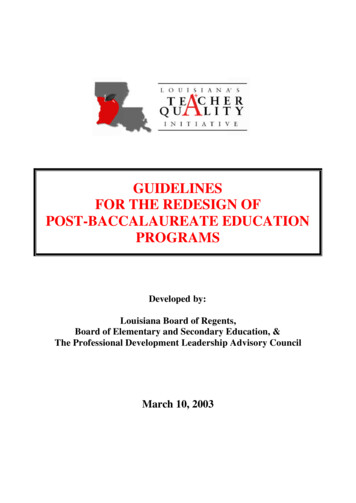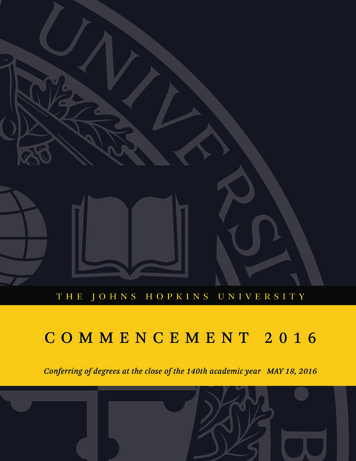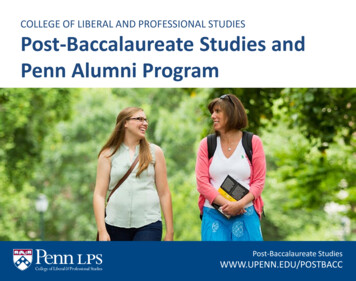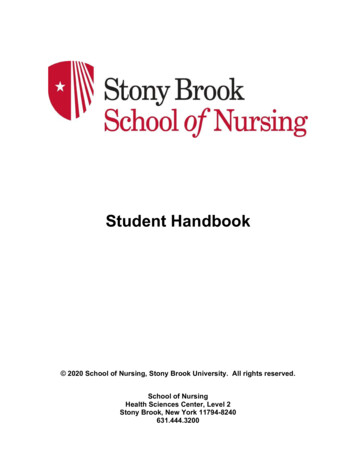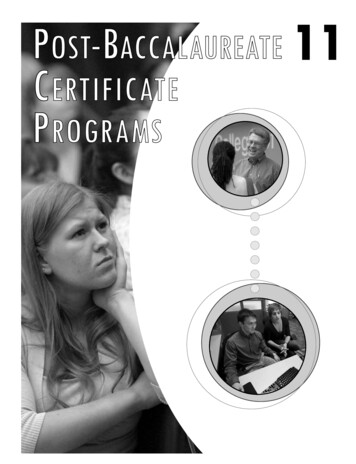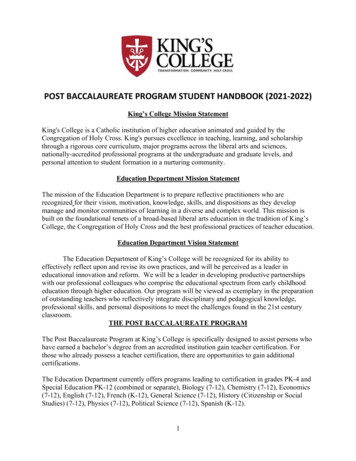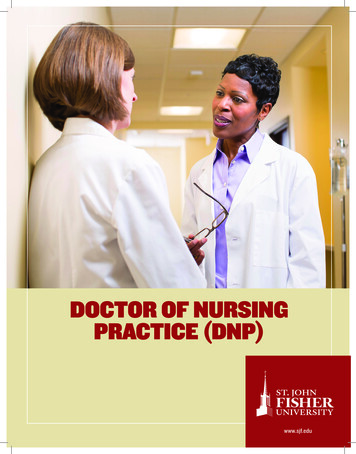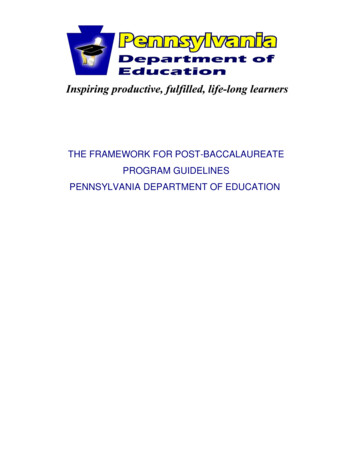
Transcription
THE FRAMEWORK FOR POST-BACCALAUREATEPROGRAM GUIDELINESPENNSYLVANIA DEPARTMENT OF EDUCATION
IntroductionThe Role of Post-Baccalaureate Programs in Pennsylvania’s Teacher PreparationThe majority of teachers in Pennsylvania and the United States obtain teacher certification bycompleting a traditional teacher preparation program as part of an undergraduate degree.i Forcandidates who already possess a bachelor’s degree and want to enter the field of teaching,post-baccalaureate programs offer the possibility of building on that degree and otherexperiences while acquiring the additional skills, knowledge, and dispositions needed tobecome a successful teacher.Beyond providing a route to certification for such individuals, post-baccalaureate programs canalso play an important role in meeting some of Pennsylvania’s teacher needs. ThoughPennsylvania does not face an overall teacher shortage, there are gaps in specific contentareas and geographical regions, as well as a need for greater diversity in the teaching force.Post-baccalaureate programs can serve to address some of these needs, and there is evidencethat many programs across the country successfully serve that purpose already.iiThe typical undergraduate candidates differ from typical post-baccalaureate candidates inimportant ways, and their preparation should therefore differ as well. At the end of a postbaccalaureate program, successful candidates receive the same certificates as prebaccalaureate candidates, and programs should therefore demonstrate how candidates haveacquired the same competencies acquired by candidates in undergraduate preparation programs.However, post-baccalaureate programs must be tailored to the specific and unique needs ofcandidates, who enter programs with established skills and knowledge. In order to assess priorknowledge and experience, the admissions, entry, and intake processes become particularlyimportant components of post-baccalaureate programs. Other program components also differfrom the pre-baccalaureate teacher preparation programs, and candidates may require differentsupports, such as mentors, during the program.Though there is not complete consensus on the ideal characteristics of post-baccalaureateteacher preparation programs, research in the field identifies multiple critical programcomponents:A design aimed to recruit and prepare individuals who already have at least a bachelor’sdegree;A rigorous selection process that includes academic selectivity and relevant subject matterknowledge;Field-based experiences with embedded candidate competencies;Candidates working closely with mentor teachers;Coursework addressing immediate candidate needs with an emphasis on pedagogy andhuman development;High performance standards for program completion; iii andRegular, comprehensive assessment woven through all program elements to ensure thatcandidates are fully prepared to teach upon completion of the program.In reviewing multiple post-baccalaureate teacher preparation programs across the nation, it isalso evident that successful programs are developed to meet the unique needs of districts andcandidates; and while they often deviate from pre-baccalaureate teacher preparation programsas a result, they still ensure that candidates acquire the necessary competencies to serve assuccessful teachers. Thus, candidates must emerge from programs with the same mastery ofthe content, pedagogy, and human development in their certificate area that their peers in prebaccalaureate teacher preparation programs achieve; but there must also be considerableflexibility in how candidates achieve that level of mastery through post-baccalaureate programs.August 4, 20092
With high expectations for program entry, an infusion of competencies in field experiences andstudent teaching where appropriate, streamlined and accelerated course delivery, strongcandidate supports, and thorough assessment tools to ensure candidate mastery ofcompetencies, the post-baccalaureate program can provide high quality teacher preparationwithout mirroring the structure of pre-baccalaureate programs.These guidelines are designed to function as a supplement to the existing CertificateFramework guidelines for pre-baccalaureate teacher preparation programs. The content andcompetencies that are required of all teachers receiving certification in Pennsylvania areoutlined in the pre-baccalaureate guidelines and are not repeated here. Rather, this documentfocuses on the key elements that distinguish Pennsylvania’s post-baccalaureate standards fromthe state’s pre-baccalaureate standards; and it provides as well examples of best practice fromacross the country to guide the creation of the post-baccalaureate programs.Specifically, the following elements of Pennsylvania’s post-baccalaureate programs areconsistent with the existing Certificate Framework guidelines for pre-baccalaureate teacherpreparation programs and can be adapted to inform the post-baccalaureate program guidelines:Mission StatementCollaboration for Program DesignProgram DeliveryFaculty QualificationsCollaboration ActivitiesEducational TechnologyOther components of the existing Certificate Framework guidelines for pre-baccalaureateteacher preparation programs are referenced throughout the document where relevant,particularly regarding the candidate competencies and expectations for field experiences.Critical Program CriteriaA successful post-baccalaureate teacher preparation program must contain six critical programcriteria. These criteria were developed with extensive input from Pennsylvania teacherpreparation programs, as well as a thorough review of available research and literatureregarding effective post-baccalaureate programs. The six critical program criteria are as follows:1. Needs Assessment & Recruitment Plan: A focus on district, regional and stateneeds for a highly qualified and diverse teacher pool.2. Admissions & Intake Process: Identifying promising candidates and assessing theirskills and knowledge.3. High Quality & Streamlined Program Design: Meeting the needs of both candidatesand school districts.4. Field Experiences & Student Teaching: Comprehensive and coordinated fieldexperiences, embedding candidate competencies throughout.5. Candidate Assessment & Program Completion: Ensuring candidates meet statestandards and are ready to enter the classroom as teachers of record through regular,comprehensive assessments.6. Candidate & New Teacher Supports: Emphasis on a range of high-quality supportsduring and following the program.Each critical program criteria is described in more detail below. In addition, best practicesgleaned from across the country are also highlighted and are provided to serve as potentialmodels to be used by institutions as they develop their post-baccalaureate programs.August 4, 20093
1. Needs Assessment & Recruitment PlanPost-baccalaureate programs can serve a critical function in meeting an array of Pennsylvania’steacher needs. Specifically, there are regions in the state that face teacher shortages, as well ascertain content areas that continually face shortages, such as math, science, and specialeducation. In addition, Pennsylvania would benefit from more diversity in the teaching force,especially among historically underrepresented minorities. Nationwide, research indicates thatpost-baccalaureate programs do in fact help to alleviate these shortages and diversify theteaching force.ivIt is important that programs have a tailored recruitment plan to try and meet these needs, as itcan be challenging to attract individuals who already possess bachelor’s degrees to the field ofteaching. One program in Texas identified recruitment as a major struggle for the program tobegin operating. In tracking their public relations efforts, they found that increasing their effortsvastly expanded their applicant pool.v Incentives can also attract candidates to programs,especially if the program is designed to meet the unique and specific needs of postbaccalaureate candidates.Pennsylvania Post-Baccalaureate Program Expectations – Needs Assessment &Recruitment Plan: Programs must recruit historically underrepresented minorities into programs to diversifythe teaching force in Pennsylvania. Programs must demonstrate that there is an effort to meet at least one high needcontent area, as defined by the state, or fill an identified shortage in a geographicalregion. Programs must provide evidence of a strong and comprehensive recruitment plan thataligns with goals to meet state needs or recruit historically underrepresented minoritiesinto teaching. Programs must ensure that potential candidates can easily access information about theprogram through such tools as:A clear website that is easy to navigate,A public relations campaign,Brochures, mailings, and pamphlets, and/orE-mails to prospective candidates.August 4, 20094
Examples of Best Practice* Incentives Attract Candidates *Offering incentives can serve as an effective recruitment tactic in attracting candidates to postbaccalaureate programs. Though not always sufficient, financial incentives such asscholarships, bonuses, loan forgiveness, employer-assisted housing, master’s degree tuitionassistance, salary incentives, and good benefits can attract individuals to the profession,according to a recent National Governor’s Association report. A recent report by the WoodrowWilson Foundation arrived at a similar conclusion, finding that, “Career changers need greaterincentives (particularly stipends, partial salary support, health care coverage, and loanforgiveness) to help them make successful transitions to teaching.” This finding was magnifiedwith the African-American and Hispanic mid-career professionals surveyed.* Addressing a Statewide Need: A Best Practice in Pennsylvania *E mc², Educating Middle-Grades Teachers for Challenging Contexts, is an experimentalprogram through Temple University designed to train mid-career and early retiree mathematicsand science professionals as middle-grade teachers. To meet Pennsylvania's crucial need formathematics and science teachers, E mc² provides an accelerated path to Pennsylvaniateaching certification that also enables professionals to begin the program while maintainingtheir current jobs. Participants receive practical and rigorous preparation to meet the needs ofindividual middle school students, with program academic coursework thoroughly integratedwith field-based experiences. E mc² offers a unique set of advantages designed to ease andspeed the transition to teaching:complete in 12 months with a cohort of similarly situated adultsa partial tuition subsidy of 5,000be eligible to receive a Pennsylvania teacher certification upon completioncoursework geared to allow continued employment at current job for at least thefirst half of the programcourses designed and taught by Temple University faculty that link mathematics orscience with teaching strategies appropriate for middle-school-aged childreninitial practical experience in cooperating schools with middle school studentsfollowed by progressively more independent and involved classroom workindependent teaching supported by master teachersvi, vii, viii2.Admissions & Intake ProcessSome researchers have found that, particularly in urban low-income communities where teacherquality is affected by shortages and the need to hire under-qualified individuals through temporaryor emergency permits, post-baccalaureate programs can help raise the quality of the teacherpool.ixThere is also some initial research on how improving teacher quality improves studentperformance. Using five years’ worth of student achievement data and historical teacher data inNew York City, one report found a modest but statistically significant improvement in theaverage achievement of students in the poorest schools with improvements in the observedqualifications of teachers. The results suggest that selecting teachers with stronger academicindicators (such as SAT scores and GPA) could substantially improve student achievement.xThe bar a post-baccalaureate program sets for admissions standards is therefore an importantone, and it can also help to ensure that candidates can quickly master the competenciesnecessary to enter the teaching profession. With a more streamlined curriculum, it isAugust 4, 20095
particularly important that the admissions process results in high quality candidates that cansuccessfully transition to teaching.The intake process is just as important as the admissions process. A thorough and rigorousadmissions and intake process, which could include tools such as a prior learning assessment ora portfolio, can both avoid duplicative coursework while maximizing a candidate’s previousexperiences in the context of the program. One of the primary reasons why post-baccalaureateprograms must be tailored to the specific and unique needs of candidates is that candidatesenter programs with established skills and knowledge. Their previous experiences cancontribute to their work in a teacher preparation program and should therefore be assessed uponentry. For example, demonstrated content expertise in the certification sought can be assessedthrough the candidates’ coursework or undergraduate degree, testing (such as GREsubject tests or certification exams), or work experience. If candidates possess prior knowledgeand demonstrated content expertise in the certification sought, their post-baccalaureateprogram can focus on pedagogy and human development, for instance, to streamline theircoursework.Pennsylvania Post-Baccalaureate Program Expectations – Admissions & Intake Process: Though no admissions and intake process is identical, approved post-baccalaureateprograms must share some key criteria:Applicants already hold a BA or BS degree from an accredited college or university;Applicants have a minimum 3.0 overall undergraduate GPA;1Applicants have 6 undergraduates credits in mathematics, and 6 undergraduatecredits in English composition (3 credits) and English literature (3 credits);2Applicants have Pennsylvania required clearances;3For a Special Education Certificate, applicants must provide evidence of an earnedPreK-4, 4-8, Secondary (7-12) or Reading Specialist certificate. Beyond this basic set of criteria, programs must demonstrate that accepted applicantsmeet a high bar for admission. Programs must develop and describe the admissionscriteria and process, as well as show that the process results in a high quality pool ofpotential candidates. Finally, according to Chapter 354, programs should go to great effort to avoidunnecessary duplication of coursework and strive to create an efficient, streamlinedprogram for candidates. (§ 354.25 (2)) One way to avoid duplicative work is to conducta thorough intake on each candidate and consider prior experiences. Programs musttherefore demonstrate a system or process for assessing prior knowledge, experience,coursework, and exam performance and a subsequent system of ensuring that theprogram is efficient, streamlined, and customized to meet candidate needs. If theprogram deems certain coursework duplication essential, it will be incumbent upon theinstitution to identify when and why duplication of coursework is necessary.1 OR receive conditional admissions contingent upon maintaining a 3.0 GPA or higher after 12 or more credits of post-baccalaureate coursework.2 OR receive notification upon program admission that the course credits must be completed in order to be recommended for certification.3 OR receive notification upon program admission that all required clearances must be in place prior to program field experiences and studentteaching.August 4, 20096
Examples of Best Practice* Accounting for Previous Experiences *Post-baccalaureate programs in Pennsylvania already employ some best practices in theintake and admissions processes. First, during the intake process, it may become clear thatsome candidates already have experience working with children and students. This experiencemay be applied towards the 40 required observation and exploration hours and/or the 150required pre- student teaching hours. In addition, some programs include a requirement forcontent mastery prior to entry. This requirement streamlines the program, allowing programs tofocus primarily on human development and pedagogy, as well as other areas central to thepractice of teaching. Programs can assess content mastery through many different means,such as exams, portfolios, transcript review, previous work experience and standardized tests(such as GRE subject tests or certification exams). Finally, some programs conduct personalinterviews with candidates after they are accepted into the program to better assess and gain adeeper understanding of previous experiences. Examples such as these demonstrate that theprogram can be streamlined, tailored to and maximizing on candidate experience, through acomprehensive intake process.3. High Quality & Streamlined Program DesignSince the typical undergraduate candidates differ from typical post-baccalaureate candidates inimportant ways, their preparation should differ as well. It is important to emphasize, though, thatupon successful completion of any approved teacher preparation program in the state, candidatesreceive the same certificates. Programs should therefore demonstrate how candidates haveacquired the same competencies acquired by candidates in pre-baccalaureate preparationprograms, while streamlining and tailoring the program to meet the specific and unique needs ofpost-baccalaureate candidates.Many participants in post-baccalaureate programs around the country are not just recent collegegraduates but are mid-career adults with work experience. One continual criticism of postbaccalaureate programs is that coursework is not tailored to candidates’ unique needs. Otherthan the time of day courses are offered, the coursework often mirrors pre-baccalaureatecertification coursework.xiIn particular, coursework for participants in post-baccalaureate programs should focus onpedagogy and human development, especially if content area expertise is established throughprogram admission and the intake process. One study noted, though, that subject-specificpedagogy was not emphasized in the majority of post-baccalaureate programs. Rather,candidates took general pedagogy coursework, which failed to address both their previousexperience and their most immediate needs.xii In addition, candidates in post-baccalaureateprograms often note the need for classroom management coursework.xiii Therefore, pedagogycourses must be subject-specific, and particular attention must be paid to classroommanagement.Research suggests that:Coursework content should be tailored to meet the needs of candidates, with particularemphasis on pedagogy, human development and classroom management;A streamlined course of study that deviates from pre-baccalaureate programs is mosteffective; andCompetencies should be embedded in multiple experiences within the program.xivAugust 4, 20097
Pennsylvania Post-Baccalaureate Program Expectations – Program Design: Programs must provide evidence that all competencies listed in the relevant CertificateFramework guidelines for each certification program are adequately addressed in termsof both depth and breadth.xv This expectation can be achieved through a combination ofprogram curricula, admissions requirements, and the intake process (to account forprevious experiences and coursework). Programs must demonstrate how and why the coursework is streamlined and differswhere appropriate from the pre-baccalaureate program in terms of course sequence andother program design elements. This differentiation in program design can be identifiedin many ways, such as:A different and flexible schedule for candidates, especially since candidates may beemployed full-time while taking coursework;Coursework that is tailored to post-baccalaureate candidates and specific coursesyllabi that differ from the equivalent pre-baccalaureate preparation course;The program results in a higher degree, such as a master’s degree;Candidates can complete the program in less than the number of creditsrecommended for the professional core of the relevant pre-baccalaureate teacherpreparation program;xviThere are multiple paths provided for different types of post-baccalaureatecandidates based on their previous experiences; andCourse content is designed to meet the immediate needs of candidates. Programs may embed competencies throughout the curriculum whereappropriate, including field experiences.xvii Programs must demonstrate that candidates are assessed in their acquisition of thecompetencies in the relevant Certificate Framework guidelines for each certificationprogram. When embedding competencies, assessment becomes a particularlyimportant program component to ensure that candidates are indeed acquiring thecompetencies.xviii In addition to course assessments and assessments thataccompany field experiences or student teaching, programs should utilize additionaloverarching assessment tools, such as portfolios, to evaluate candidates.Examples of Best Practice* Embedding Competencies Outside of Courses: A Best Practice *“When we began mapping competencies to courses, it became clear to us that the major placein which we reinforce professionalism is in student teaching. Here we have a chance toimmerse the student in the school experience and mentor him or her in best practices. Whilewe have discussed professionalism in almost every course, here is where it becomes real forstudents.”– Professor Ward Cates, Lehigh UniversityxixAugust 4, 20098
4. Field Experiences & Student TeachingField experiences and student teaching are central components of all professional educatorprograms. As regulated by Chapter 354 of the Pennsylvania Code (Title 22), field experiencesbenefit candidates by providing opportunities to apply principles and theories from the program toactual practice in the classroom, as well as practice with diverse populations, ages, and schoolsettings (§354.25(d)(1-2). Though diverse experiences are important, it is also vital thatcandidates have a strong clinical experience in the specific areas in which they are preparing toteach. Mentors can assist in providing a well-rounded field experience, helping candidatesintegrate pedagogy, theory and practice.As some candidates enter post-baccalaureate programs with previous experiences with childrenand in classrooms, the field experiences should be adapted from the Certificate Frameworkguidelines to meet the specific and unique needs of post-baccalaureate candidates.xx Overall, theexpectations for post-baccalaureate candidates are consistent with expectations for prebaccalaureate candidates, including but not limited to:A minimum of 190 hours of field experiences prior to student teaching – 40 hours ofobservation and exploration and 150 hours of pre-student teaching; andA minimum 12 week full-time supervised student teaching experience.Though the guiding principles of field experiences and student teaching do not differ, some ofthe practices should be adjusted to provide a better overall experience for candidates.xxiPA Post-Baccalaureate Program Expectations – Field Experiences & Student Teaching: Programs must demonstrate how field experiences and/or student teaching have beenadapted from the Certificate Framework guidelines to meet the specific and uniqueneeds of post-baccalaureate candidates, especially for those that enter postbaccalaureate programs with previous experiences with children and in classrooms. Programs must provide evidence of partnership and ongoing collaboration withparticipating schools and educational settings, which may be provided in many ways,such as:A detailed partnership agreement with through a memorandum of understanding orsimilar documentation;A log of communication;Information about advisory boards, listservs, or other formalized networks forpartnership and communication;Lists of all partnering entities and points of contact; andLetters from partners indicating the level of involvement and collaboration.It is incumbent upon the program to demonstrate the quality – not just amount – ofcommunication, collaboration, and partnership. Programs must demonstrate that the program was designed with input and collaborationfrom partnering schools and educational settings, and that the program design isconsistently informed by feedback and communication with those partners. Programsshould include evidence of the following:Programs are thoughtful of the time commitment required of partnering schools andeducational settings;Programs are aware of the different needs and levels of experience of postbaccalaureate candidates; andPrograms aim to coordinate coursework with field experiences and student teachingthrough the partnerships with schools and educational settings.August 4, 20099
Programs must provide information about the sequence and duration of fieldexperiences, as well as how these experiences are closely integrated with coursework,assessment practices, and program goals.Examples of Best Practice* Streamlining and Tailoring Field Experiences and Student Teaching *Some post-baccalaureate programs in Pennsylvania have already identified bestpractices regarding field experiences and student teaching:In many of the schools where candidates complete student teaching, the semesterextends beyond the 12 weeks required. Some programs use this additional time toincorporate pre- student teaching field experience hours prior to student teaching.Candidates who have recent experience working with children and in classroomsmay already meet the requirement to complete 40 observation and explorationhours. When programs take this experience into account during intake process, theprogram is further streamlined and tailored to the unique needs of the postbaccalaureate candidate.* Teaching Residencies: Innovation in Field Experiences and Student Teaching *Teaching residencies are non-traditional routes to teacher certification for post-baccalaureatecandidates. These yearlong residency programs train teachers through field-basedexperiences supplemented by coursework and mentoring. Typically, these programs are inurban, high-need school districts and teachers ultimately work in high-need schools. There aremultiple urban teaching residencies around the country, but the Boston Urban TeachingResidency is cited most often as the national model.During the year-long teaching practicum, Boston Urban Teaching residents take master’s levelcoursework, participate in collaborative teaching, and receive intensive mentoring from currentteachers. The teaching residents are not teachers of record during their yearlong residency,but they are paid and make a commitment to teach as the teacher of record for three yearsbeyond the yearlong residency. Further, teaching residents are supported through establishedinduction programs during their first three years of teaching.A recent study by NCATE identified seven key characteristics of teaching residencies:1. Weaving education theory and classroom practice tightly together in a year-long residencymodel of highly relevant teacher education;2. Focusing on Resident learning alongside an experienced, trained and well-compensatedmentor;3. Preparing candidates in cohorts to cultivate a professional learning community,foster collaboration, and promote school change;4. Building effective partnerships and drawing on community-based organizations to promote a“third way” for teacher preparation;5. Serving school districts by attending to both their teacher supply problems and curriculargoals and instructional approaches;6. Supporting Residents for multiple years once they are hired as teachers of record; and7. Establishing incentives and supporting differentiated career goals to retain Residents andreward accomplished and experienced teachers.xxii, xxiii5. Candidate Assessment & Program CompletionEspecially in a streamlined program where competencies are embedded throughout, it is criticalthat candidates can demonstrate that they have mastered the competencies and have met thesame bar for certification as their pre-baccalaureate peers. In addition, in reviewing programsAugust 4, 200910
across the nation, the USDE identified the standards for program completion as an essentialcomponent for post-baccalaureate programs.xxivTherefore, programs should include detailed assessment at regular intervals throughout theprogram, as well as an overarching, comprehensive assessment for candidates, to ensure thatcandidates have not just completed the program but have met a high standard and are ready toenter the classroom as the teacher of record.PA Post-Baccalaureate Program Expectations – Candidate Assessment and ProgramCompletion: Programs must demonstrate that candidates are given clear and specific expectationsregarding assessment and program completion. Programs must provide a holistic plan of assessment that demonstrates how candidatesare assessed at regular intervals throughout the program, including the assessmenttools used during coursework and field experiences. The assessment plan mustdescribe both formative and summative assessment strategies, and note all efforts toconnect assessment and candidate growth and improvement. It should be clear fromthe integrated assessment plan that assessment is woven throughout all programcomponents and connects to the cumulative, comprehensive assessment strategy. Programs must demonstrate that there are consistent, formative assessments in place.Programs must indicate how candidates will receive ongoing performance feedback toidentify areas of improvement and develop a strategy for growth. Programs must alsoindicate that there is a feedback loop in place that supports and consistently allows forcandidate improvement. In addition, programs mus
competencies, the post-baccalaureate program can provide high quality teacher preparation without mirroring the structure of pre-baccalaureate programs. These guidelines are designed to function as a supplement to the existing Certificate Framework guidelines for pre-baccalaureate teacher preparation programs. The content and
